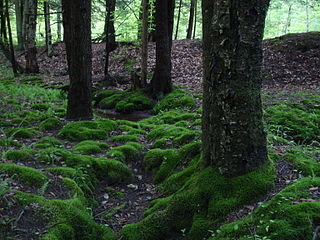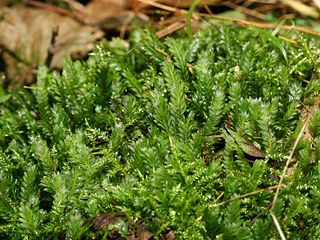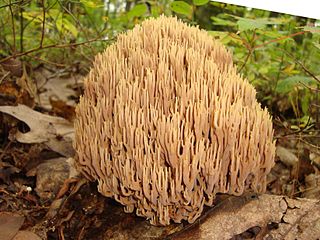
In biology, a spore is a unit of sexual or asexual reproduction that may be adapted for dispersal and for survival, often for extended periods of time, in unfavourable conditions. Spores form part of the life cycles of many plants, algae, fungi and protozoa.

Mosses are small, non-vascular flowerless plants in the taxonomic division Bryophytasensu stricto. Bryophyta may also refer to the parent group bryophytes, which comprise liverworts, mosses, and hornworts. Mosses typically form dense green clumps or mats, often in damp or shady locations. The individual plants are usually composed of simple leaves that are generally only one cell thick, attached to a stem that may be branched or unbranched and has only a limited role in conducting water and nutrients. Although some species have conducting tissues, these are generally poorly developed and structurally different from similar tissue found in vascular plants. Mosses do not have seeds and after fertilisation develop sporophytes with unbranched stalks topped with single capsules containing spores. They are typically 0.2–10 cm (0.1–3.9 in) tall, though some species are much larger. Dawsonia, the tallest moss in the world, can grow to 50 cm (20 in) in height. There are approximately 12,000 species.

Fissidens adianthoides, the maidenhair pocketmoss, is a moss in the family Fissidentaceae. It was first collected by Hedwig in 1801.

Sphagnum is a genus of approximately 380 accepted species of mosses, commonly known as sphagnum moss, also bog moss and quacker moss. Accumulations of Sphagnum can store water, since both living and dead plants can hold large quantities of water inside their cells; plants may hold 16 to 26 times as much water as their dry weight, depending on the species. The empty cells help retain water in drier conditions.
Bartramia may refer to either of two genera:
Monoicy is a sexual system in haploid plants where both sperm and eggs are produced on the same gametophyte, in contrast with dioicy, where each gametophyte produces only sperm or eggs but never both. Both monoicous and dioicous gametophytes produce gametes in gametangia by mitosis rather than meiosis, so that sperm and eggs are genetically identical with their parent gametophyte.

Ceratodon purpureus is a dioicous moss with a color ranging from yellow-green to red. The height amounts to 3 centimeters. It is found worldwide, mainly in urban areas and next to roads on dry sand soils. It can grow in a very wide variety of habitats, from polluted highway shoulders and mine tailings to areas recently denuded by wildfire to the bright slopes of Antarctica. Its common names include redshank, purple forkmoss, ceratodon moss, fire moss, and purple horn toothed moss.

Bartramia halleriana, the Haller's apple-moss or Haller's bartramia moss, is a species of moss in the family Bartramiaceae.

Bartramia pomiformis, the common apple-moss, is a species of moss in the Bartramiaceae family. It is typically green or glaucous in hue, although sometimes it can appear yellowish. The stems extend from a half cm to 8 cm, with narrowly lanceolate to linear-lanceolate leaves 4 - 9 mm long. The leaves have a nerve and are toothed. They are curled when dry but stick out when moist.

Ramaria stricta, commonly known as the strict-branch coral is a coral fungus of the genus Ramaria. It has a cosmopolitan distribution, and grows on dead wood, stumps, trunks, and branches of both deciduous and coniferous trees. Its fruit body is up to 10 cm tall, made of multiple slender, compact, and vertical parallel branches. Its color is typically light tan to vinaceous-brown. All parts of the mushroom will bruise when handled. There are several lookalike corals that can usually be distinguished from R. stricta by differences in coloration, bruising reaction, or microscopic features. The fungus is inedible due to its unpleasant odor and bitter taste.

Splachnaceae is a family of mosses, containing around 70 species in 6 genera. Around half of those species are entomophilous, using insects to disperse their spores, a characteristic found in no other seedless land plants.

Pogonatum urnigerum is a species of moss in the family Polytrichaceae, commonly called urn haircap. The name comes from "urna" meaning "urn" and "gerere" meaning "to bear" which is believed to be a reference made towards the plant's wide-mouthed capsule. It can be found on gravelly banks or similar habitats and can be identified by the blue tinge to the overall green colour. The stem of this moss is wine red and it has rhizoids that keep the moss anchored to substrates. It is an acrocarpous moss that grows vertically with an archegonium borne at the top of each fertilized female gametophyte shoot which develops an erect sporophyte.
The Field Elm cultivar Ulmus minor 'Viminalis Stricta' (:'narrow'), formerly known as U. campestris var. viminalis stricta, is a fastigiate form of Ulmus minor 'Viminalis'. A herbarium specimen at Kew labelled U. campestris var. viminalis f. stricta was considered by Melville a form of his U. × viminalis.

Bartramia is a genus of mosses in the family Bartramiaceae. The genus was first formally described by Johann Hedwig in 1801. There are about 72 species, usually growing on soil, sometimes on rocks, in many habitats in many parts of the world, although tropical species are only found at high altitudes. Nine species occur in Australia but only three of these are endemic to that continent.
Bartramia nothostricta is a species of mosses in the family Bertramiaceae and is endemic to the south-east of Australia. It grows in small colonies in moist places, and is recognised by its leaves which look like a shaving brush and by its bright green, spherical, lollipop-like capsules.

The Field Elm cultivar Ulmus minor 'Hunnybunii pseudo-Stricta' was originally identified as U. nitens var. Hunnybunii pseudo-StrictaMoss by Moss in The Cambridge British Flora (1914). Moss regarded the tree as a "subvariety" of U. nitens var. 'Hunnybunii', with a narrower form.

Buxbaumia viridis, also known as the green shield-moss, is a rare bryophyte found sporadically throughout the northern hemisphere. The gametophyte of this moss is not macroscopically visible; the large, distinct sporophyte of B. viridis is the only identifying structure of this moss. This moss can be found singularly or in small groups on decaying wood, mostly in humid, sub-alpine to alpine Picea abies, Abies alba, or mixed tree forests. This moss is rare and conservation efforts are being made in most countries B. viridis is found in.

Splachnum rubrum, is a species of moss in the Splachnum genus which is found in the Northern Hemisphere. Like other species in the Splachnum genus, it is known for growing on animal waste and being entomophilous. Although very rare, its bright red-purple sporangia makes its sporophyte stage stand out well when seenin the wild.













